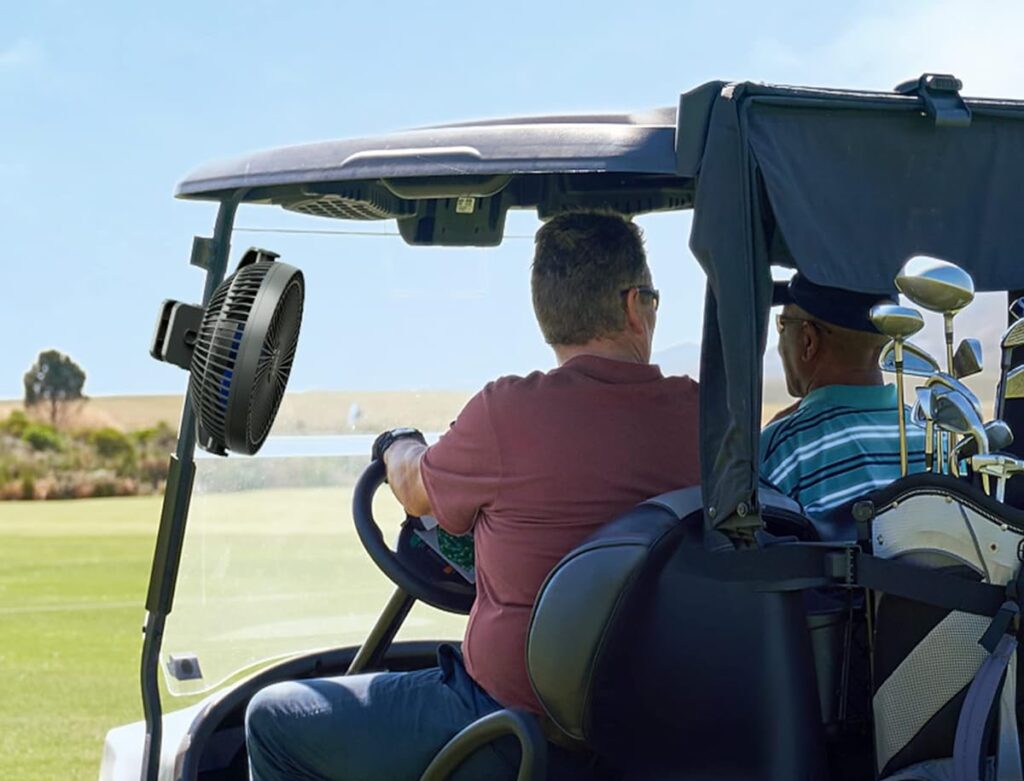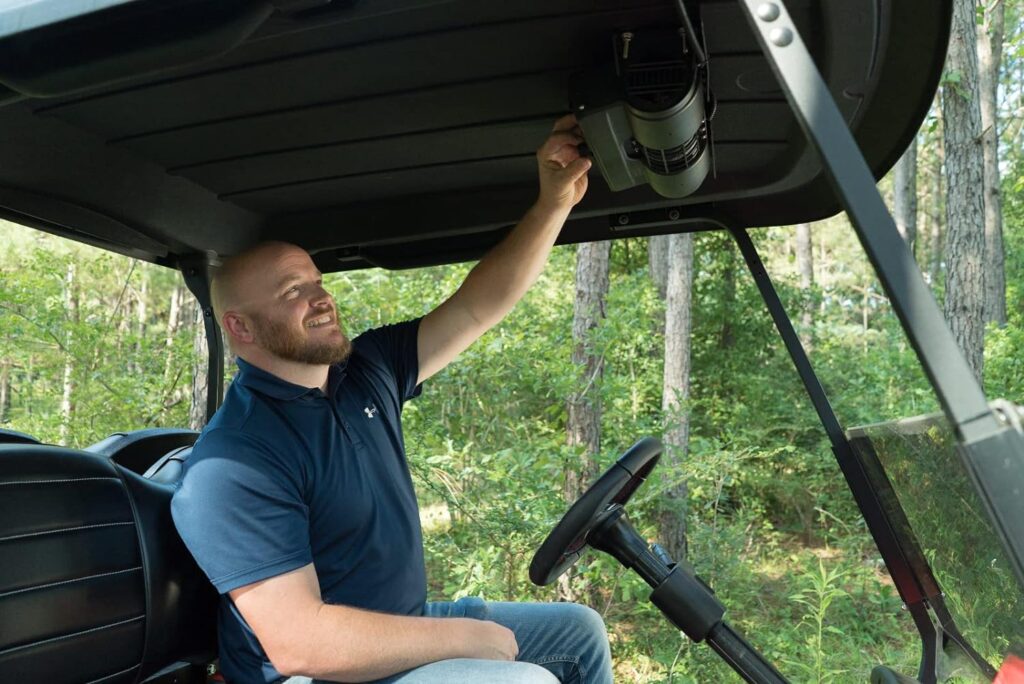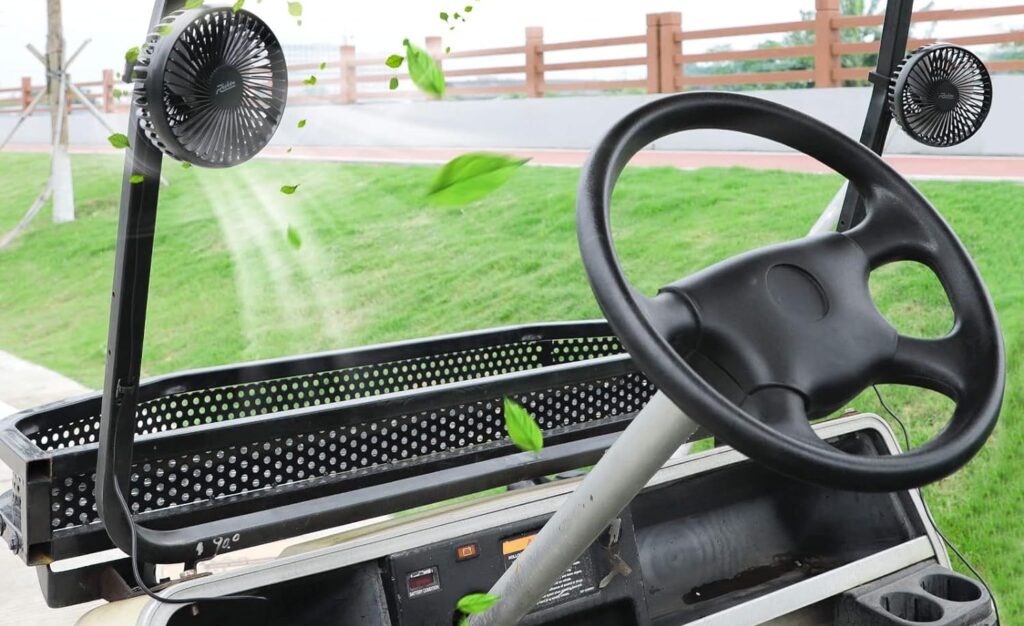Keeping cool on the golf course is important, especially on hot summer days. A good cooling fan can make all the difference in comfort when you’re playing a round in your golf cart. In this buyers’ guide, we’ll explore some of the best cooling fan options to install in your golf cart. From small portable fans to full cart ceiling fans, we’ll cover the pros and cons of different types of cooling fans. You’ll learn key factors to consider like power source, size, and adjustability. We’ll also provide specific product recommendations on the top cooling fans to keep you breezy on the links. With the right golf cart cooling fan, you can play 18 holes in style and stay chill even on sweltering days. Read on for the definitive guide to the best cooling fans to equip your golf cart with!
1. xasla Portable Rechargeable Clip on Fan for Golf Cart

The xasla 10000mAh Portable Rechargeable Clip on Fan packs a powerful punch in a compact package. Running on a built-in 10000mAh rechargeable battery, this fan can operate for an impressive 24 hours on a single charge. With its integrated USB-C and micro USB ports, the battery fully recharges in just 6 hours.
This versatile fan features four speed settings to provide customized airflow. On the highest speed, it generates robust breeze while maintaining quiet operation from 20 to 40 decibels. The 8 inch fan head rotates a full 360 degrees to direct air where you need it. Weighing only 1.1 pounds, the fan’s lightweight clamp base allows securing it virtually anywhere – desktops, golf carts, treadmills, and more.
Pros And Cons
Pros:
- Long 24 hour runtime per charge
- Ultra-portable at 1.1 pounds
- 360 degree rotation
- Quiet 20-40 dB operation
Cons:
- Small 8 inch fan head
2. NIVEL Breezeasy 3 Golf Cart Fan System

The NIVEL Breezeasy 3 is a versatile automotive-grade cooling fan designed specifically for golf carts and UTVs. With universal mounting brackets, it can be installed in multiple positions to direct its robust airflow where you need it.
This fan generates an impressive 310 cubic feet per minute of breeze through dual inlets and outlet vents. The three-speed settings allow adjusting airflow for customized cooling power. It operates quietly while providing maximum air circulation throughout the cart’s interior.
Installation is simplified with the included mounting hardware and color instructions. The fan is compatible with 12V to 48V systems, thanks to the built-in voltage reducer, making it a universal fit for most gas and electric golf carts.
Weighing only 4.4 pounds, the durable polyethylene housing resists weather and impacts while maintaining a stylish low profile. For golfers seeking professional-grade cooling power in a versatile, easy-to-install fan, the NIVEL Breezeasy 3 is an excellent choice.
Pros And Cons
Pros:
- Powerful 310 CFM airflow
- Universal mounting brackets
- Built-in voltage reducer
- 3 fan speed settings
Cons:
- No smart features or remote
3. Koonie Rechargeable Clip on Fan for Golf Cart

The Koonie 10000mAh Rechargeable Desk Fan delivers robust personal cooling with cordless convenience. Powered by a built-in 10000mAh battery, it provides up to 24 hours of continuous use per charge. The integrated USB-C port enables fast charging, with a full recharge taking just 6 hours.
This 2-in-1 fan functions as both a sturdy clip-on unit and a standalone desk fan. The clip’s strong clamp grips edges up to 3 inches thick, making it ideal for desks, treadmills, golf carts and more. For desk use, the fan’s base keeps it upright and stable.
With its 8-inch diameter 3 blade design, this fan generates a smooth, quiet airflow. The adjustable head rotates 360 degrees to direct the breeze where needed. Four speed settings plus an energy saving mode offer personalized cooling power. Weighing only 1.76 pounds, the plastic housing feels durable yet remains lightweight and portable.
Pros And Cons
Pros:
- 24 hour runtime per charge
- Fast 6 hour recharge time
- Ultra quiet operation
- 360 degree adjustable head
Cons:
- Fan head is small at 8 inches
4. Roykaw Portable Golf Cart Fan

Specifically designed for golf carts, the Roykaw Golf Cart Fan provides personalized cooling on the course. This USB-powered fan securely mounts to square tubing on cart frames up to 1-1/4 inches thick, making it compatible with leading brands like EZGO, Club Car and Yamaha.
The sturdy bracket keeps the fan locked in place, even when driving on bumpy terrain. The adjustable head rotates a full 360 degrees to direct the breeze where needed. Three speed settings allow you to customize the airflow. The brushless motor delivers robust wind power while maintaining quiet operation.
Installation takes just minutes by screwing the mounting bracket onto the cart frame. The detachable mesh grille makes periodic cleaning simple. With its golf cart-friendly mount, focused airflow and easy maintenance, the Roykaw Golf Cart Fan is engineered to beat the heat on the links.
Pros And Cons
Pros:
- Designed specifically for golf carts
- Locking mount prevents shaking loose
- 360 degree adjustable head
- 3 speed settings
Cons:
- USB power source limits runtime
5. YONHISDAT Misting Fan Rechargeable

The YONHISDAT Misting Fan combines cooling mist and breeze in a portable, rechargeable unit. The 8-inch fan generates a smooth airflow up to 11.8 feet per second on the highest of three settings. Integrated mist nozzles transform the air into a fine, evaporative spray for an extra cooling effect.
The 125ml removable water tank feeds the mist function which can run continuously or in 10 second intervals. On lower settings, misting lasts up to 90 minutes per refill. The integrated 10000mAh battery powers up to 28 hours of use and enables operation while charging.
This 2-in-1 fan also functions as a clip model, portable desk fan, or hanging unit courtesy of the sturdy clamp and foldable hook. The adjustable head rotates 360 degrees to direct wind and mist where desired. Convenient preset timers of 1, 2 or 5 hours allow customizing runtime before auto shutoff.
Pros And Cons
Pros:
- Misting provides added cooling effect
- 28 hour runtime on single charge
- Preset timer function
- Clamp and hook for portability
Cons:
- No smart features or app control
How to Choose the Best Cooling Fan for Your Golf Cart?
Driving around in a golf cart on a hot summer day can quickly become unbearable without proper cooling. Installing an efficient cooling fan on your cart can make all the difference in keeping you comfortable on the course. But with so many options on the market, how do you select the best cooling fan for your needs? This guide will walk you through the key factors to consider when choosing a golf cart cooling fan.
1. Determine Your Cooling Needs
The first step is deciding how much cooling power you need. Small portable fans that attach to the roof or seat are great for light breezes. But if you play in extremely hot climates, consider a high-powered ceiling fan that circulates air throughout the cart.
Think about when and where you typically drive your golf cart. If it’s for leisurely community trips, a basic fan will suffice. Frequent players in hot regions should opt for maximum cooling power. Identifying your cooling needs will narrow the field.
2. Consider the Available Power Supply
Golf cart cooling fans require a power source, so it’s crucial to assess what’s available in your cart. Most carts have a 12V battery, in which case a 12V DC powered fan is the way to go. This avoids needing an inverter that can drain the battery.
Some newer carts have a 120V AC outlet, allowing you to use a plug-in AC fan. Though convenient, be mindful of total wattage used to prevent overloading the cart. Checking your power supply early on will prevent headaches down the road.
3. Evaluate Size and Mounting Options
Pay close attention to both sizing and mounting configurations when selecting a golf cart cooling fan. Measure your cart’s interior dimensions to ensure the fan will fit. Also, determine the best mounting location based on air flow. Roof mounts allow flexibility while ceiling mounts focus cooling.
Consider universal mounts that adjust for angle and rotation. This added versatility enables directing the airflow exactly where you need it most. Prioritize fans with adjustable mounts to optimize cooling in your cart.
4. Look for Speed and Runtime Control
Any quality cart cooling fan should provide speed control via settings like low, medium and high. Variable speed allows balancing cooling power and battery usage. Also look for fans with timers that can be preset to run for a certain duration.
For maximum flexibility, choose a fan with multiple speeds and timer functions. This puts you in control over the fan’s cooling capabilities and electricity usage via your cart’s battery. Don’t settle for single speed fans without runtime controls.
5. Seek Out Durability and Weather Resistance
Golf carts get used in all types of weather, so your cooling fan must withstand the elements. Ensure the fan is made of durable materials that won’t easily corrode. Also confirm the electrical components have water-tight covers and seals if going with an outdoor ceiling mount.
Searching for weatherproof fans ensures it will hold up to rain, sun exposure and other outdoor conditions. Don’t let a flimsy fan ruin your investment – always opt for maximum durability.
What are the benefits of adding a cooling fan to your golf cart?
Adding a cooling fan to your golf cart can provide several benefits that improve the overall golfing experience. The most obvious advantage is that a cooling fan makes the interior of the golf cart more comfortable in hot weather. Golf is played primarily in the spring and summer months when temperatures can get quite high. Sitting in an unventilated golf cart under the hot sun can quickly become unpleasant. The airflow from a quality cooling fan blows away the stagnant hot air and allows for a breeze that makes the interior feel cooler. This keeps golfers from overheating and getting irritable or fatigued from the heat while on the course.
Another benefit of installing a cooling fan is that it helps prevent sensitive electronics from overheating. Most modern golf carts have several electronic components and sensors that can malfunction or shut down if they get too hot. For example, the cart’s speed controller operates more efficiently and reliably when kept cool. The electronics for the GPS system, Bluetooth speaker, USB chargers, and other accessories will last longer if protected from excessive heat. A properly sized cooling fan circulating air through the golf cart’s electronics bay prevents critical failure of these components.
Cooling fans also provide benefits to the golf cart itself. Golf cart batteries, whether lead-acid or lithium-ion, will degrade faster when exposed to high temperatures. Keeping the batteries cooler with a fan will extend their life and reduce replacement costs. The fan can also keep the motor and drivetrain components cooler, reducing wear and the chances of overheating or seizing up. The overall longevity and performance of the golf cart improve with a cooling fan maintaining proper operating temperatures.
Finally, the rush of cooling air from a fan can help clear dust that accumulates inside a golf cart when driving on the course. Keeping the interior space cleaner reduces irritation from dust and pollen for golfers with allergies or respiratory issues. The airflow also keeps odors from building up inside wet or muddy golf bags and other equipment stored in the cart. Overall, installing a high-quality cooling fan enhances comfort, convenience, electronics reliability, and the condition of the golf cart for a better golfing experience.
What types of cooling fans are available for golf carts?
There are a few main types of cooling fans used to improve airflow in golf carts. The most basic are axial fans, which work by drawing air along the axis of the spinning blades and blowing it out in a direction perpendicular to that axis. Axial fans provide a straightforward airflow pattern and are relatively affordable. They come in a range of sizes to match the cubic feet per minute (CFM) rating required to properly cool the golf cart.
Another common type is a blower fan. These utilize an impeller wheel inside a housing to create high-velocity, high-volume airflow. Blower fans are more powerful than basic axial fans and can move air over a longer distance. They work well when mounted on the rear of a golf cart to force air throughout the interior. The high airflow helps cool golfers and electronics while also preventing stagnant air pockets.
Oscillating mount fans are a third option. As the name implies, these fans pivot side to side to spread the airflow over a wide area. The oscillating function ensures consistent cooling across all the passenger seats. They can be mounted on the roof or side of the cart and adjusted to direct air where it’s needed most.
Many golf carts also utilize small electric muffin fans to directly cool electronics and batteries. These compact fans fit into tight spaces and boost airflow around sensitive components. Most muffin fans mount internally near the electronics while larger axial or blower fans handle the overall interior cooling.
The most advanced option is DC powered fans designed specifically to run off the golf cart’s battery bank. This avoids having to convert DC power to AC. DC fans also typically offer various speed settings to customize cooling power. Overall, golfers should look for rugged, water-resistant fans able to withstand dust and debris when selecting the best type of cooling fan for their needs.
What features should you look for when choosing a golf cart cooling fan?
One of the most important factors is CFM rating. CFM stands for cubic feet per minute and indicates how much air the fan can move. A higher CFM rating means more cooling power. Match the CFM rating to the size of your golf cart’s interior for optimal airflow. Also consider the fan’s duty cycle, which indicates how long it can run safely before needing a rest. Choose a continuous duty cycle fan if you plan to use it for extended periods.
The fan’s power source is another key consideration. Fans powered directly by the golf cart’s DC battery system are convenient since they don’t require inverting DC to AC power. DC fans designed for solar power systems are also available. Just ensure the voltage matches your golf cart’s battery bank. AC-powered fans will require an inverter.
Evaluate the durability of the fan’s construction. Metal guards protect the blades while powder-coated housings resist corrosion. Since the fan is mounted on the outside of the golf cart, it must withstand bumps, vibrations, rain, and dust. Look for fans advertised as vibration and water resistant.
Convenience features are also nice to have. Adjustable mountings make it easy to direct the airflow. Multiple speed settings allow adjusting the airflow volume. Thermostats activate the fan automatically when the interior gets too hot.
Lastly, pay attention to design factors like size, weight, and noise level. Make sure the fan mount location has enough space and support for the weight. Larger fans move more air but might vibrate or be louder. Consider a diffuser shroud if the direct airflow is too strong. Getting the right cooling fan features improves comfort and protects your golf cart.
Where is the optimal location to mount a cooling fan on a golf cart?
The most common placement for a main cooling fan is centered on the rear of the golf cart roof. Mounting it here allows the airflow to blow into the rear seating area and then circulate forward through the entire cart. It essentially pushes air into the interior cabin, creating positive pressure that forces hot air out. This location works well for larger axial or blower fans designed to cool the whole interior.
Smaller muffin-style fans can be mounted inside the golf cart aimed directly at the electronic components and battery compartment. This helps keep sensitive controllers, sensors, and batteries from overheating. Just be sure the fan you select is designed for enclosed spaces and has the CFM rating to adequately cool the electronics.
Oscillating mount fans are popularly positioned on the passenger side roof support beam. The benefit is they blow air directly on the occupants to prevent overheating. Oscillating models spread the cooling effect to the driver and passenger seats. They can also be adjusted as needed depending on sun exposure and wind direction.
If your golf cart has a canopy or enclosed cab, consider dual rear mounting points. Fans placed on each rear corner provide balanced airflow that effectively flushes the interior. The dual fan arrangement also provides redundancy if one fails. Just be aware this takes up more roof space.
Lastly, check your golf cart manual as some models recommend specific fan locations. The key is finding spots that allow sufficient airflow volume through the most important areas while minimizing noise and vibration. Proper mounting is crucial to maximize the benefits of adding cooling fans.
Do golf cart cooling fans really make a difference in hot weather?
The most obvious benefit is the sensation of a cooling breeze that keeps golfers from overheating. On a blazing 90 degree day, the interior of a cart can reach extreme temperatures that feel unbearable. Powerful airflow from well-placed fans literally blows away the hot, stagnant air and replaces it with more tolerable breezes. This cooling effect helps prevent golfers from getting fatigued, irritated, and drained of energy during their round.
The ventilation from cart fans also prevents electronics like GPS devices from shutting down due to overheating. Carts today are loaded with sensitive electronics that can malfunction or fail when they get too hot. Effective cooling fans maintain safe operating temperatures for these components. The same goes for the motor and battery system – cooling prevents premature wear and failure.
Golf cart cooling fans also keep the interior cleaner by preventing dust and pollen buildup. Oscillating fans circulate fresh air in and out rather than allowing the inside to become musty and contaminated. The moving air also discourage spiders and pests from nesting in the cart.
While basic shade structures help block direct sun exposure, they do little to actively cool the interior. Only fans provide the kind of vigorous airflow needed to beat the heat. Golfer reviews consistently cite cart cooling fans as an excellent investment that allows playing in comfort on hot days. So while they may seem like a luxury, cooling fans provide essential relief when you’re spending 4+ hours under the intense sun.
FAQs when choosing the best cooling fan for a golf cart
What type of power source do golf cart cooling fans need?
Most golf cart cooling fans are designed to run on 12V DC power which is supplied by the cart’s battery. It’s important to match the voltage of the fan to the cart’s power output to ensure proper operation. There are some 120V AC powered fans available but this requires installing an inverter to convert the DC battery power to AC.
How do I determine the cooling capacity I need?
Consider the climate you’ll be driving in, number of passengers, and sun exposure to gauge your cooling needs. For very hot regions and frequent use, look for high velocity ceiling fans that maximize airflow through the entire cart. For milder weather or occasional use, a portable clip on fan may provide enough cooling power.
What size fan will fit my golf cart?
Measure the interior dimensions of your golf cart to find a fan that will fit properly. Look for fans with adjustable mounting brackets that provide flexibility for angling the direction of airflow. Roof mount fans tend to be compact while ceiling fans require more overhead space.
How important is adjustability for golf cart fans?
Being able to control the angle and rotation of the fan is very important for optimizing airflow. Look for universal mounts that allow adjusting the pitch and swivel of the fan. The ability to direct air where it’s needed most provides better cooling flexibility.
What type of speed and runtime controls should I look for?
Seek out fans with variable speed settings and timers that allow presetting the duration of operation. Multiple fan speeds let you adjust cooling power and battery usage. Timers prevent draining the battery by limiting runtime. Combining both gives you maximum control over cooling and electricity consumption.
What weather protection features are most important?
Since golf carts are used outdoors, the fan must be durable and water resistant. Metal parts should be corrosion-proof, electrical components sealed, and blades able to shed moisture. Fully enclosed motors and shrouds guarantee the fan holds up to rain, sun, and other elements.
What are the best places to install a golf cart fan?
Roof and ceiling mounts are most popular. Roof mounts allow aiming the airflow and are easy to install. Ceiling fans chill the whole interior but take up headroom. Seat clip-on fans provide very targeted cooling. Combining a roof fan up front with a clip fan in back gives both directed and overall airflow.
Final Thoughts
Staying cool on the golf course is a breeze when you have the right cooling fan equipped on your golf cart. By taking into account your specific cooling needs, power supply, size constraints, adjustability, speed control, durability, and ideal mounting locations, you can select the perfect golf cart fan for beating the heat. Whether you desire maximum airflow, portable convenience, or all-around climate control, there are great options to enhance comfort and keep you chilled out on the links. With this guide’s tips in mind, you can confidently choose a high-performing cooling fan tailored for your golf cart. Now you can drive in cool comfort and focus on improving your handicap rather than sweating through 18 holes!
Enjoyed this guide of the best cooling fan for golf cart? Then be sure to check out our other golf guides.